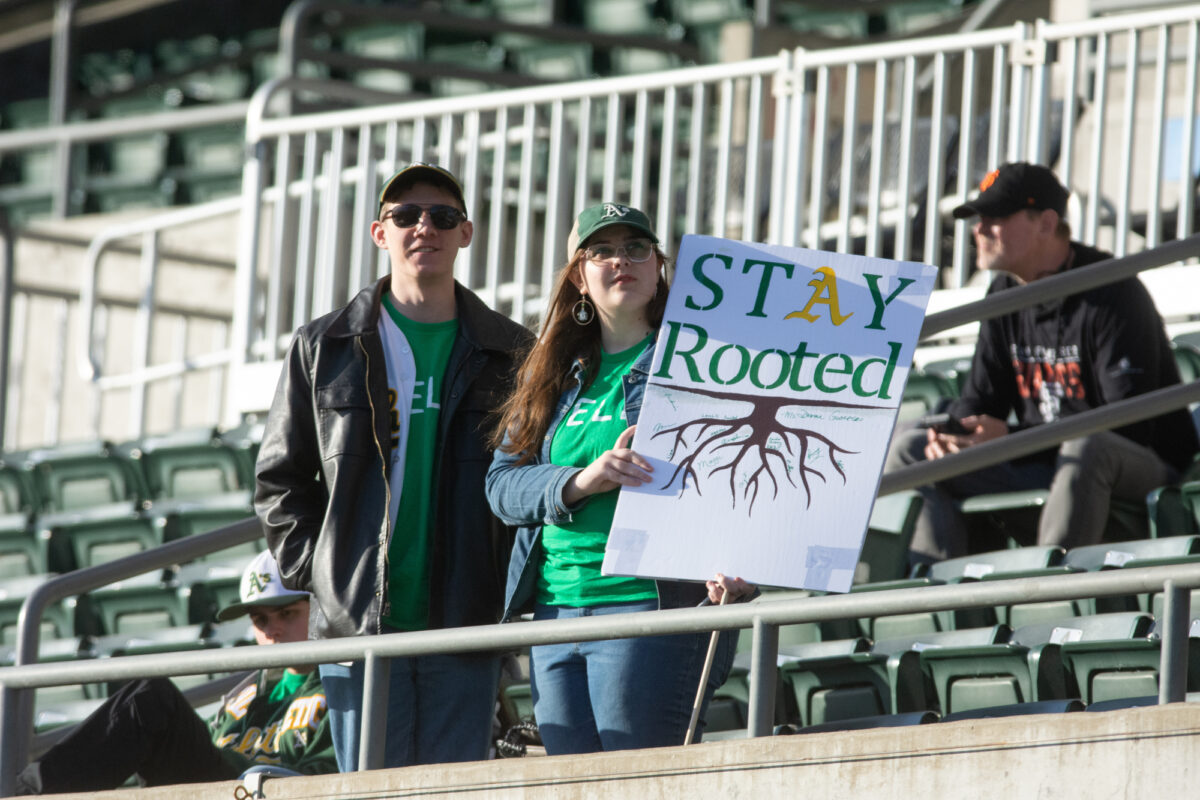A’s stadium bill language arrives, caps public financing at $380M

A measure aimed at bringing the Oakland A’s to Las Vegas, introduced Friday in the Senate, proposes a state and Clark County-offered public financing package of no more than $380 million to fund a portion of the construction of a $1.5 billion stadium.
The Nevada Independent reported details of the proposal Friday morning after obtaining a draft of the bill language before it was formally introduced in the Senate.
Much of the previously announced structure of the public financing package is contained in the draft bill language, including $180 million in transferable tax credits issued by the state and $120 million in bonds issued by Clark County. But publication of the bill language — which could still change before the measure is formally introduced in the Legislature — is the first look at the scope of the financing deal negotiated by the franchise and state and county leaders.
SB509, brought on behalf of Gov. Joe Lombardo’s office, expands the mandate of the Las Vegas Stadium Authority, created in 2016 to oversee and manage Allegiant Stadium, to have the same responsibilities for the A’s new ballpark. The Stadium Authority is managed by a nine-person board.
The bill does not call for new revenue, so passage would only require a simple majority vote — instead, relying on a combination of tax credits from the state, county bonds paid off through tax-increment financing (in a format also known as a TIF district) and a 30-year property tax exemption separate from the public financing provided directly for the project. The A’s would also be responsible for any cost overruns.
As drafted, the bill also requires Clark County to create “a resort corridor homelessness prevention and assistance fund” managed in partnership with the Major League Baseball team and the Nevada Resort Association. The fund would be aimed at reducing homelessness in and around the Southern Nevada resort corridor but would not receive contributions from the Stadium Authority until construction was complete and debt obligations met.
The bill’s $380 million in public financing is roughly $120 million less than the $500 million in public funding the A’s originally sought after announcing a “binding agreement” for a stadium site north of Allegiant Stadium on April 20.
That bid was abandoned on May 15 in favor of a site at the south end of the Strip that includes the Tropicana Las Vegas. The A’s have spent much of the past two years scouring the Las Vegas Valley in an effort to relocate from the Bay Area. The team’s whirlwind process saw rapid changes in financing details and potential stadium sites pinballing between backroom discussions and media reports during the past month.
The bill language emerges with fewer than 11 days left in the state’s 120-day legislative session, and more than three weeks after Democratic legislative leaders told reporters that lawmakers would soon “run out of time” to make an A’s deal happen without resorting to a special legislative session.
However, a potential A’s deal is at risk of falling apart amid a deepening rift between legislative Democrats and Lombardo over the state budget. On Thursday, Assembly Speaker Steve Yeager (D-Las Vegas) and Senate Majority Leader Nicole Cannizzaro (D-Las Vegas) said in a press conference that they would not move to advance any policy legislation — including an A’s bill — until Lombardo has signed the budget, which could hit the governor’s desk as soon as this weekend.
Lombardo has now twice threatened to veto the state budget — though without specifying if he would veto all or just some of the five separate bills that make up the budget — if Democrats did not move to pass key measures proposed by his office.

By the numbers
The public financing package outlined in the draft bill language would mandate a limit on public spending of no more than $380 million, or the amount of money generated and contributed to the construction fund via taxes, fees or another funding mechanism (whichever is lesser).
The bill allows the Stadium Authority to authorize up to $180 million in transferable tax credits from the state for stadium development, capped at $36 million in credits annually. However, if the Stadium Authority issues more than $90 million of those transferable tax credits out of the pool of $180 million, it would eventually be responsible for repaying any excess dollars to the state using tax revenues generated by the stadium district. The tax credits expire five years after the issue date.
Transferable tax credits are issued by the state and can be redeemed against an entity’s owed payroll tax, gaming license tax or insurance premium tax, and can be sold to other businesses for cash. Companies often sell these credits to help finance the development of projects.
Similar transferable tax credit programs have been established in state law for the film industry and for the Tesla Gigafactory. Tesla notably sold some of its transferable credits to MGM. The tax credits issued by the state essentially reduce the amount of money in the state’s general fund for use on other government programs and services.
Under the measure, Clark County would be required to issue an unspecified amount of bonds making up the difference from what is contributed via transferable tax credits. The combined funding is capped at $380 million.
County sources estimate that the county will contribute at least $120 million in bonds (an amount that could change depending on interest rates). The bill would also require the county to pay a $25 million credit allocated toward infrastructure costs associated with the development agreement, meaning the total potential public contribution to the project could be at least $325 million.
The bill would allow the county to pay those bonds through the creation of a so-called “mega-TIF,” a tax financing district drawn around the stadium area in which all tax revenues generated by the stadium, including sales and payroll taxes, would be pledged to pay off the public financing for the stadium. If the county creates the district to pay off the bonds, those tax revenues would be redirected from county services and programs that they would otherwise flow toward.
The bill also would authorize the state treasurer to provide a credit enhancement on those county bonds in order to improve the credit rating or credit risk profile of the county and obtain better terms of repaying debt. That includes giving broad flexibility to the State Infrastructure Bank — established in 2021 to provide low-cost financing to government agencies for priority infrastructure projects — to provide financial assistance to support paying off the bonds.
Capping public financing for the project at $380 million means the Oakland A’s will be responsible for upward of $1.1 billion in costs. Included in the bill is a requirement that the project’s developer partner will pay for the initial $100 million in costs.
The bill also includes language that would exempt the stadium site from paying property taxes for 30 years. It stipulates that the Stadium Authority owns and oversees the stadium, and the Major League Baseball team enters into a 30-year lease with the public oversight body.
As part of the measure, the authority would be exempt from paying property taxes, adding a substantial tax break to the potential $380 million in public financing for the stadium. A source close to the negotiations estimated the 30-year property tax exemption could be equivalent to almost $55 million over that time period.
Through the development agreement, the team would be penalized for relocating or leaving the stadium before 30 years have passed. Penalties would take the form of damages equal to the outstanding amount to repay bonds and any costs associated with terminating bonds early.
As another way of raising funding for the construction of the project, the Stadium Authority would be able to sell “personal seat licenses” (PSLs), which guarantee a buyer first rights to purchase tickets for a particular seat. The PSLs sold by the Las Vegas Raiders cost thousands of dollars each.
Once the Stadium Authority pays off a majority of the debt associated with the stadium construction and development and the project is complete, it would then be required to contribute at least $5 million each fiscal year to “a resort corridor homelessness prevention and assistance fund.”
If costs rise past expectations for the proposed $1.5 billion construction, the development agreement would require that the developer partner, referring to the team, be responsible for “any and all development and construction cost overruns,” unless the overrun was caused by a change mandated by the Stadium Authority.
The bill language does not mention the Oakland A’s or the Tropicana, specifically describing the effort as “the financing of a Major League Baseball stadium project.”
A source familiar with the negotiations said the bill language purposely does not specify a location, similar to the process undertaken by lawmakers in 2016 in creating $750 million in public funding to attract the Oakland Raiders to Las Vegas. Lawmakers approved the financing package in a special session in October 2016, and the Raiders acquired the site that became Allegiant Stadium in May 2017.
The proposal to provide location flexibility to the Oakland A’s also comes as the organization has had binding agreements in place for two different parcels of land in Las Vegas, and explored additional sites.
No matter where the A’s play, the state will not receive revenue from a tax on admissions to the team’s home games in Las Vegas. Under existing state law, professional sports teams playing home games in the state — including the Las Vegas Raiders and the Las Vegas Golden Knights — are exempt from the Live Entertainment Tax.

What’s next?
Like other legislation, the bill draft request must first be introduced by one or more lawmakers or a legislative committee. That introduction came Friday evening on the Senate floor, which met for marathon sessions ahead of a midnight deadline to clear hundreds of policy bills as the legislative session winds to a close.
After it was introduced in an informal “behind the bar” committee meeting ahead of a late-evening floor session on Friday — and after an extended delay where the bill language remained unavailable through the Legislature’s online portal hours after it was introduced — SB509 was referred to the Senate Finance Committee. That’s the first venue where lawmakers, lobbyists and members of the public will be able to publicly comment on the substance of the bill language, and the first opportunity for lawmakers to publicly question bill backers.
Ordinarily, the bill would then require a work session and committee vote agendized for a separate day. However, under the increased time pressures of the session’s final days, committee leaders can waive standing rules and vote to advance or amend the bill on a compressed timeline, if necessary.
Only then would the bill finally hit the Senate floor for an initial vote, where, if passed, the bill would repeat the process in the Assembly before hitting Lombardo’s desk for a signature.
An analysis by the Legislative Counsel Bureau suggests the bill will not require a two-thirds vote for passage, essentially avoiding the high constitutional bar (two-thirds of the members of each house) for any legislation that would increase taxes in Nevada.
If signed into law as-is, the bill would require the Clark County Commission to take a series of actions — functionally circumventing a vote by the seven-member board, which has at least one member, Commissioner Tick Segerblom, who has shown reluctance to back public money for an A’s stadium, even as he tweeted earlier this month that he would support a potential A’s move.
First, the bill would require commissioners to create a “sports and entertainment improvement district” in unincorporated Las Vegas — in this case the resort corridor — that includes only the land for the stadium project “and any surrounding or adjacent properties necessary for the operation of the” project. The district would be used to “assist in the financing of a Major League Baseball stadium project,” though commissioners would still be able to “amend or modify” the boundaries of that district through an ordinance.
Second, the bill would require Clark County to issue the general obligation bonds.
Approval by the Legislature is one sign-off needed by the A’s before construction could start on the ballpark. Major League Baseball’s relocation committee would also need to approve the project by Jan. 1. Major League Baseball Commissioner Rob Manfred said a vote on the A’s relocation to Las Vegas could come when league owners meet from June 13-15 in New York, the Associated Press reported.
The proposed stadium’s proximity to Harry Reid International Airport means the team will also require approval from the Federal Aviation Administration before beginning construction.
The A’s have a “binding agreement” with Bally’s Corp., which operates the Tropicana Hotel and Casino, to use 9 acres of the 35-acre site for the 30,000-seat, retractable roof stadium — a capacity that would rank as the smallest in the Major Leagues. Bally’s is giving the team the land for free. The stadium is expected to open in time for the 2027 Major League Baseball season.
Real estate investment trust Gaming and Leisure Properties (GLPI) owns the entire site on Tropicana Avenue and the Strip. Bally’s pays GLPI $10.5 million in annual rent.
Bally’s is expected to operate the hotel-casino for at least 18 to 24 months before closing the resort for the stadium construction. Bally’s officials have suggested the company will demolish the hotel-casino and build a new resort on the site. GLPI said it would provide $175 million for “shared improvements” on the site.
On Friday morning, A's released initial renderings of the proposed ballpark, which appears to take up more than 9 acres of the site.
An A's spokesman wrote in a text message that the ballpark covers 9 acres, but there is also "shared public space," including the entrance to the site.
"We've confirmed the ballpark dripline is 9 acres. We also have a 67-foot buffer outside of the ballpark and a couple of acres of plaza space," she said, quoting the A's director of design.
This story was updated at 11:26 p.m. on 5/26/23 to include the official bill language introduced in the Senate.
This story was updated at 11:08 a.m. on 5/26/23 to include the renderings and comments from the A's.
This story was updated at 10:04 a.m. on 5/26/23 to specify details about county bonding.



